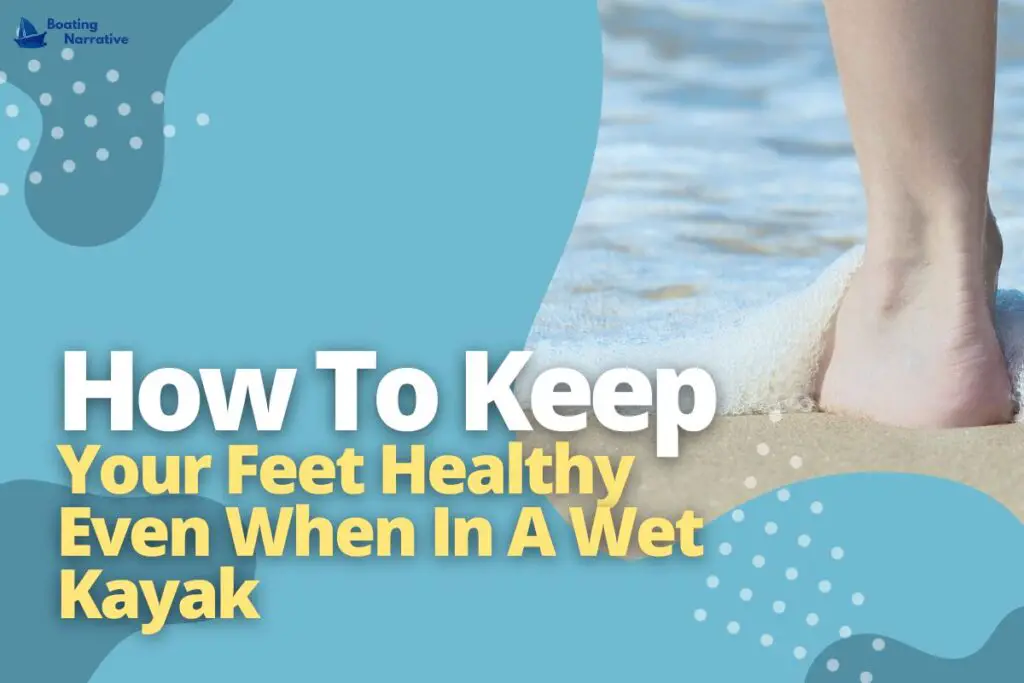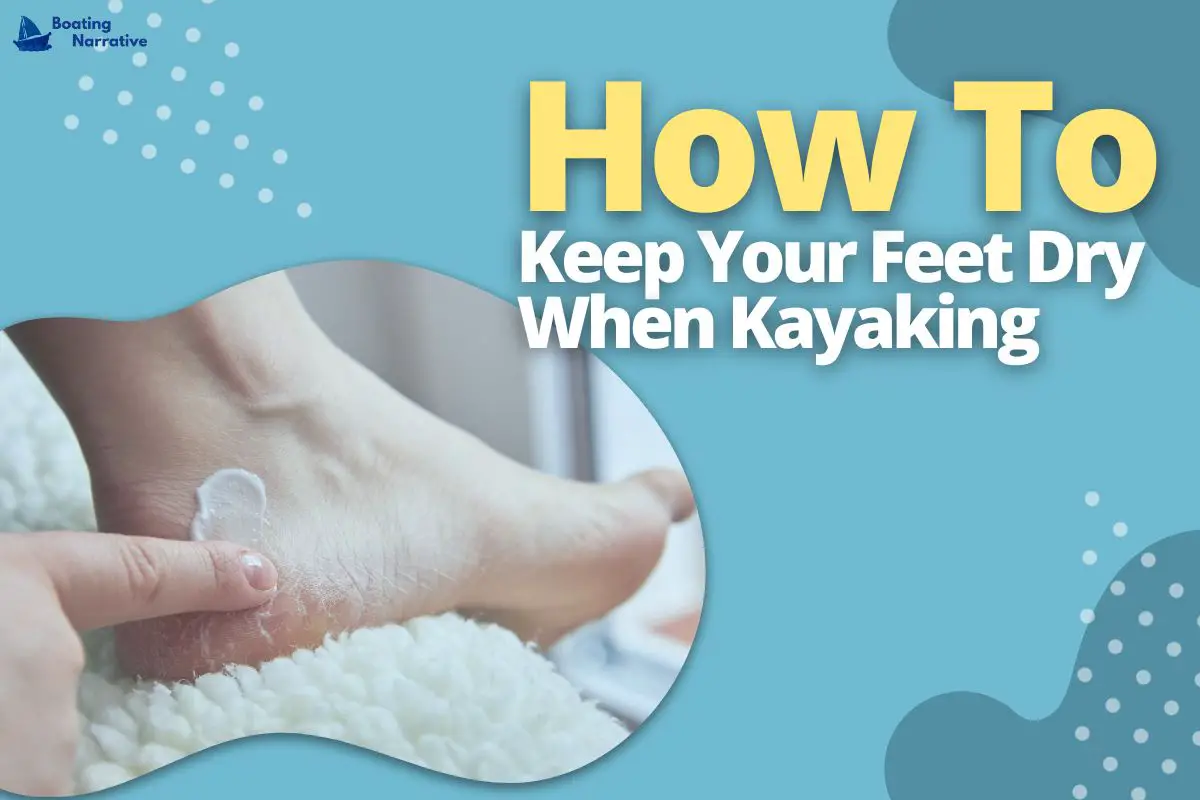Kayaking is a great way to spend a day. It’s fun and relaxing, and you can even go fishing. But kayaking isn’t all fun and games. You’ll also have to deal with rain if you’re a serious kayaker.
You’ll need to spend money on a pair of waterproof socks if you want to avoid getting your feet wet when kayaking. There are also neoprene shoes and water shoes.
I’ll tell you everything I know about waterproof socks in this article. Additionally, I’ll explain where to get the best water shoes and neoprene shoes for kayaking.

Here’s The Answer To How To Keep Your Feet Dry When Kayaking
You can do a few things to keep your feet dry when you go kayaking.
- Wear paddle boots. These are basically like shoes, but they have waterproof material on the bottom so that your feet don’t get wet when you paddle.
- Wear a dry suit. This is a full-body suit that you can put on over your clothes. It keeps you completely dry but can be hot in the summer.
- Go barefoot. This is fine if the water temperature is warm and there isn’t a lot of water. However, if it is cold or there is a lot of water, you may want to consider wearing something on your feet.
There are a few different types of kayaking shoes. One is a sandal with drainage holes. This is a good choice for warmer weather or if you will be in the water frequently. Another option is a neoprene bootie.
These are made of a thicker material and are suitable for cold days or if you will be in the water for a long time. There are also kayaking shoes that are made of fleece.
These are good for cold days or if you will be in the water for a long time. There are also canoe shoes that are made for canoeing. Again, these are a good choice if you are going to be in the water for a long time or if you are going to be in rough terrain.
Use Kayak Spray Skirt

A kayak spray skirt is a fabric barrier that helps you stay dry while paddling. It wraps around the cockpit of your kayak, separating the water outside from your body inside. If you wear it properly, it’ll keep most of the water out.
To use a kayak spray skirt:
- Put it on before getting into the kayak, and make sure all straps are secure and tight—but not too tight. The straps shouldn’t cause discomfort or make it difficult to shift in and out of your seat.
- Adjust any buckles or zippers, so they’re even with each other along their entire length (they shouldn’t be bunched up at one end). This will help prevent them from popping open unexpectedly during use or washing cycles afterward!
- Don’t forget about accessories like foam pads at either end where there may be extra material flapping around where you don’t want it—and don’t forget about using those pegs if needed (or even just threading them through holes if possible). The more snugly everything fits together here, the less likely any leaks will occur.
Wear Neoprene Boots
Neoprene boots are the best option for keeping your feet dry and warm. They’re more expensive than other options, but they’re also more comfortable to wear and more durable.
They provide good traction and are much thinner than other boots, so you can still paddle comfortably. However, before wearing neoprene boots on your upcoming kayaking vacation, there are a few drawbacks.
First, neoprene boots can be slippery on rocks and pebbles. Wearing shoes with strong traction is a good idea if you’re kayaking for the first time or in an area with slick rocks.
Second, neoprene booties don’t provide as much protection as water shoes. You may consider wearing a water shoe for kayaking in rough waters or whitewater.
Wear Synthetic Waterproof Socks
Few aspects of footwear are more crucial than ensuring your feet stay dry. When your socks contact the water, they will be the first to get wet, which can cause blisters and other foot issues that can ruin an entire day on the river.
While any pair of socks will keep your feet dry for short periods if you’re not moving too quickly in cold water (i.e., most rivers), they won’t last long under continuous soaking conditions like those experienced while kayaking.
To prevent hypothermia and ensure comfort during longer paddling sessions, it’s best to wear synthetic rather than cotton socks. Which quickly absorb moisture when wet and waterproof them with a silicone inner lining.
Wear Water Shoes Designed To Drain Water From The Shoes

If you wear water shoes for kayaking, ensure they’re designed to drain water from the shoe. This can be done in several ways:
- The material above the sole has tiny holes for drainage.
- There are small drain holes in the sides of the shoe that can be opened and closed.
- There is a hole at the heel of your foot so that water will flow out when you step on it (this is more common than you might think).
How Can You Make Sure Your Boat Does Not Get Waterlogged?
- Use a Spray Skirt. A spray skirt is employed to keep you dry if your body runs into choppy water or is thrown over by a wave. When kayaking, you will want to make sure that the skirt fits tightly around your waist so that no water can get inside of it when waves splash over the side of your boat. Additionally, you can get skirts with zippers, so you won’t have to bother about adjusting the fit each time you go kayaking.
- Use a Bilge Pump: If you want extra protection against water getting into your boat while kayaking, consider using both devices together. With this combination, there’s no way for any amount of splashing from waves or rough waters. Whether caused by Mother Nature or inexperienced paddlers affects its integrity as an effective vessel.
How To Keep Your Feet Healthy Even When In A Wet Kayak?

- Keep your feet dry.
- Don’t let your feet get too cold.
- Don’t let them get too hot, either.
- And, for goodness’ sake, don’t let them get sweaty. Sweaty feet are the worst: they make a mess of the boat, and if you’re paddling in cold conditions, they’ll even make you colder by reducing the circulation around your body—a double whammy that can lead to frostbite (and we don’t want any of that).
So what should you do? Here are a few tips:
Use Foot Powder
- Blisters can be avoided, and dry feet can be maintained with foot powder.
- You can avoid fungus and keep your feet dry by using foot powder.
- Powder for your feet might help keep them dry and fresh-smelling.
- Athletes’ feet can be avoided and kept dry with the aid of foot powder.
Put Foam Toe Separators Between Your Toes

Use foam toe separators in between your toes to keep your feet dry. This simple fix can make all the difference in a long kayak trip, especially if you’re on an all-day excursion or out overnight.
You should also wear synthetic socks with some traction to help prevent slipping inside your kayak boots or water shoes.
Don’t Wear Tight Shoes
The first and most obvious solution to dry feet when kayaking is to wear shoes that are the right size or slightly loose. Tight shoes can cause blisters, chafing, hot spots, cramping, and general discomfort.
And if you’re out in a boat on the water, this can lead to losing your balance which could result in falling overboard (not good!).
So here are some tips for choosing the right kind of footwear for kayaking:
- Don’t buy cheap sneakers that will fall apart after a few uses.
- Buy Neoprene ones instead – neoprene breathes and allows for better airflow around your foot and is more durable than synthetic materials such as nylon/polyester blends used in cheaper versions of this type of footwear (although there are exceptions).
- Look out for brands that make good quality products at reasonable prices, which means they’ll last longer than cheaper alternatives. It still offers protection against hazards like sharp rocks while allowing air circulation around your toes when needed. So that they don’t get sweaty during long periods spent paddling through choppy waters.
Don’t Wear Cotton Socks
It is advised to avoid wearing cotton socks if you want to keep your feet dry. This is because cotton absorbs water and holds onto it rather than letting it evaporate away.
This means that if you get your feet wet while kayaking or rafting, the moisture won’t be able to escape as easily. It also means that those sweat-soaked socks will be even more uncomfortable when you’re paddling downriver on a hot summer day with no breeze.
Some people may argue that cotton is better for keeping warm because it retains heat, but proper insulation will prevent cold from reaching the skin in the first place; there’s no need for this extra layer of warmth and dampness.
Opt instead for synthetic waterproof materials such as PVC. These fabrics are breathable, allowing air circulation between layers and offering better insulation without trapping heat next to the skin.
As well as being less likely than cotton fibers not only absorb but retain moisture which could lead to chafing during long days out on the water–and lastly, they’re waterproof, so once again, keeping those puddles out of here.
Use Insulation On The Inside Of Footwear
In addition to the external waterproofing, there are also several internal options. The most typical solution is to use sock liners, small pieces of fabric with an adhesive backing that go into your shoes and act as a barrier between your foot and the rubber sole underneath.
A more extreme option is to use neoprene shoes or socks instead of just a liner; these products will provide more insulation against cold water and sweat buildup than just a liner.
You can get them in both boot length (which will cover up to about mid-calf) and shorter lengths that go over the ankle area if you’re looking for something more discreet.
One thing to note: neoprene won’t breathe as well as other fabrics do, so if you’re planning on doing lots of paddling in hot weather conditions, then it’s probably best not to use this material any more than necessary (i.e., try not to wear boots all day long).
Conclusion
You can see numerous options for keeping your feet dry when kayaking. However, when it comes down to it, everyone has their preferences; thus, there is no perfect option.
Waterproof footwear is the best choice for keeping your feet dry. Waterproof footwear will keep your feet dry even if you are in the water. It is important to remember that waterproof footwear will not keep you completely dry, but it will keep your feet dry and out of the water.
Waterproof footwear can be purchased at most stores that sell kayaks and online retailers.
So, purchase waterproof footwear if you are looking for the best way to keep your feet dry when kayaking. Thanks for reading this blog post. Check out more blog posts on our website.
Frequently Asked Questions
What Materials Are Best To Keep Your Feet Dry When Kayaking?
Is It Safe To Wear Lightweight Socks Or No Socks On My Feet When Kayaking?
How can I avoid getting the fungus on my feet while kayaking?
– Soak your feet in cold water for a few minutes before paddling. This will help remove any sweat or oils on your skin
– Wipe your feet dry with a soft cloth when you’re done kayaking
– Do not use harsh chemicals or ordinary powder as this could damage your skin.

